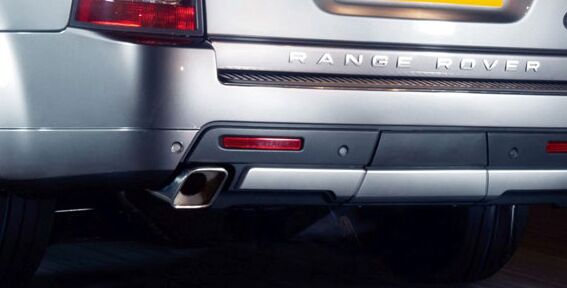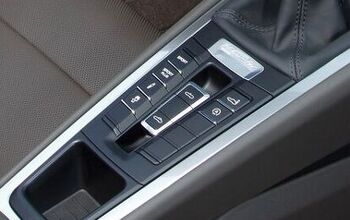QOTD: What Are The Worst Automotive Details?

It’s time to devote yet another column to automotive details. The sharp-minded among us may be annoyed by this, since I already covered this subject last week. But this time, things are different. This time, it’s negative. And negative sells. I know that because I live in Atlanta, home of CNN, who drives around in large panel trucks with huge printed signs on each side that say: “HAVE YOU SEEN SOMETHING BLOODY? TWEET US!”
Anyway: negative automotive details. I’ve got a few suggestions and, as always, I’m asking for your help to uncover more. For those of you curious as to why I’ve done so many question-and-answer posts lately, I promise there is a reason, namely that I’m going out of town in two weeks and I want to compile all the answers into a few posts that you can read while I’m gone. But also it’s because I love reading the responses, to the point where I was up last time until 2 a.m. Googling “BMW glovebox flashlight.”
Here are my nominations for some of the worst automotive details, based on a few of the cars I’ve owned. Feel free to share yours.
Range Rover Parking Sensors
It’s hard for me to believe that any single thing is more infuriating than the parking sensors on my Range Rover. (Re-reading this sentence, it sounds like someone who might say: “I just can’t get the temperature of my spa quite right.”) Seriously, though: I often think that I would gladly come home and discover that a burglar entered my home, stole all of my clothes, then let in a two-year-old child who drew all over the walls in Sharpie, all if it meant I no longer had to deal with my Range Rover parking sensors.
This is the problem. I’m backing into a parking space, so the sensors automatically activate. That’s great. They start beeping. Beep. Beep. Beep. Perfect. Then I get closer. Beep beep. Beep beep. Then I get super close. Beeeeeeeep. Exactly what I want to hear. So I stop parking and place the vehicle in park. And what happens next? You guessed it: Beeeeeeeep! Once the sensor goes on, it does not turn off, even if the vehicle is no longer in gear. So you’re parked and maybe you’re waiting for someone, and you just sit there listening to Beeeeeeep! And yes, you can manually turn off the sensor, but then you must manually turn it back on again when you’re trying to leave.
If you happen to know the person who designed these sensors, kindly provide me with their address so I can dispatch a crew of clothes-stealing burglars and creative, marker-wielding two-year-olds.
Mercedes Next Track Steering Wheel
Owning a Mercedes is an unusual decision that I strongly recommend you only make if you can stomach a) tremendous depreciation, or b) substantial maintenance costs. In fact, it’s often both of those things, and never neither.
The detail that upset me most about Mercedes ownership, however, was none of that. It was the lack of a steering wheel ‘next track’ button.
Allow me to explain. The steering wheel of most Mercedes models, like any luxury car, is covered with buttons. On my 2007 E-Class, the total number was eight, just to be precise. But this is where the anger comes in: of those eight buttons, not one controlled the next stereo track! Instead, we had volume, phone, and four buttons for the “driver information center,” which you use approximately once a month when people ask: What kinda mileage duzzis thing get?
Gated Automatic Transmissions
I will never in my life understand why gated automatic transmissions exist. One of you out there in readerland probably has a completely valid explanation that makes perfect sense in your mind, but trust me: you’ve never had to explain it to an elderly person in the hot sun.
I once worked at a large rental car agency, and we had to deliver a car to an elderly driver after her previous rental, a Dodge Avenger, broke down. (Shocking, right?) So we brought her a Suzuki Forenza, which has a gated automatic shifter, and I spent the next 30 minutes attempting to explain how it works. Unfortunately, I was at a loss for words when she asked why it works that way. I still am.
Cadillac CTS Foot-Mounted Parking Brake
Before I got my current CTS-V Wagon, I had a CTS-V sedan, which was a fairly decent car in many ways – except for one glaring detail. No, I’m not talking about the plastic center stack, which derived its material from a Playskool toy. I am instead referring to the foot-mounted parking brake.
You’re probably thinking: What’s the big deal? A lot of cars have foot-mounted parking brakes! And that’s very true. The difference, however, is that most of those cars don’t have manual transmissions. The CTS-V did. That meant there were four pedals in the driver footwell, and the one you never wanted to press was directly next to the one you had to press each time you changed gear.
So, folks, what are your worst automotive details? It’s Friday night and my girlfriend is out of town, which can only mean one thing: 2 a.m. automotive Googling. Bring it on.
@DougDeMuro is the author of Plays With Cars and the operator of PlaysWithCars.com. He’s owned an E63 AMG wagon, road-tripped across the US in a Lotus without air conditioning, and posted a six-minute lap time on the Circuit de Monaco in a rented Ford Fiesta. One year after becoming Porsche Cars North America’s youngest manager, he quit to become a writer. His parents are very disappointed.

More by Doug DeMuro
Latest Car Reviews
Read moreLatest Product Reviews
Read moreRecent Comments
- TheEndlessEnigma I would mandate the elimination of all autonomous driving tech in automobiles. And specifically for GM....sorry....gm....I would mandate On Star be offered as an option only.Not quite the question you asked but.....you asked.
- MaintenanceCosts There's not a lot of meat to this (or to an argument in the opposite direction) without some data comparing the respective frequency of "good" activations that prevent a collision and false alarms. The studies I see show between 25% and 40% reduction in rear-end crashes where AEB is installed, so we have one side of that equation, but there doesn't seem to be much if any data out there on the frequency of false activations, especially false activations that cause a collision.
- Zerocred Automatic emergency braking scared the hell out of me. I was coming up on a line of stopped cars that the Jeep (Grand Cherokee) thought was too fast and it blared out an incredibly loud warbling sound while applying the brakes. I had the car under control and wasn’t in danger of hitting anything. It was one of those ‘wtf just happened’ moments.I like adaptive cruise control, the backup camera and the warning about approaching emergency vehicles. I’m ambivalent about rear cross traffic alert and all the different tones if it thinks I’m too close to anything. I turned off lane keep assist, auto start-stop, emergency backup stop. The Jeep also has automatic parking (parallel and back in), which I’ve never used.
- MaintenanceCosts Mandatory speed limiters.Flame away - I'm well aware this is the most unpopular opinion on the internet - but the overwhelming majority of the driving population has not proven itself even close to capable of managing unlimited vehicles, and it's time to start dealing with it.Three important mitigations have to be in place:(1) They give 10 mph grace on non-limited-access roads and 15-20 on limited-access roads. The goal is not exact compliance but stopping extreme speeding.(2) They work entirely locally, except for downloading speed limit data for large map segments (too large to identify with any precision where the driver is). Neither location nor speed data is ever uploaded.(3) They don't enforce on private property, only on public roadways. Race your track cars to your heart's content.
- GIJOOOE Anyone who thinks that sleazbag used car dealers no longer exist in America has obviously never been in the military. Doesn’t matter what branch nor assigned duty station, just drive within a few miles of a military base and you’ll see more sleazbags selling used cars than you can imagine. So glad I never fell for their scams, but there are literally tens of thousands of soldiers/sailors/Marines/airmen who have been sold a pos car on a 25% interest rate.






































Comments
Join the conversation
My pet peeve is UNLIT cruise control switches...either stalk-mounted, as in my C-Class, or steering wheel mounted, as in my wife's Accord. Can't see them at night. Trying to put the cruise on at night in an unlit cabin.....not easy, causes me to take my eyes off the road. I liked Toyota's design on these a few years ago (mid-90's Celica)....the switch was installed in such a way that it was just below the center hub of the steering wheel, right where a typical driver's right thumb would be if his hand was in the 2:00 position on the wheel...and it was transparent where the text was on the switch, with a tiny bulb inside the switch, so that at night, at speed, you could see the control easily in your peripheral vision, drop your thumb to it nearly effortlessly, and engage the cruise confidently without having to fuss, take your eyes off the road, or turn on the interior map-light. Wonder how many accidents are caused by this? A total lack of ergonomic and safety recognition on the part of the designers.
Worst detail? COLOR!! Or more precisely, the utter lack of it. Is it the grim times we live in, or have manufacturers been restricting color options for so long that the buying public has forgotten how color can enhance an ordinary car. Exterior; Once upon a time, 15-20 exterior colors were routinely offered. All greens(from dinner mint- to forest-), turquoises, yellows, most blues (from sky- to navy-) and most dark reds (brick, maroon, eggplant, plum) have all but disappeared from the color palette offered on most cars today. Now, six or seven selections are your only choice. And of those, one is black, one is white, and the rest are shades of dirt (greys & beiges). Only a basic red is thrown in so there is at least one exciting color to put in the ads. Interiors? For almost two decades only mouse grey and mouse beige were offered on almost every single make of car on the road. Today there are a few daring manufacturers that offer black. Big deal. Only a Detroit-based company would try to sell a Ford Fusion Titanium in Palm Springs, Miami or Dallas with an interior that ONLY comes in black leather. Some manufacturers are offering other colors. You can get red upholstery in a Dodge Charger. At last!!! But like every other manufacturer that offers a hint of color, the red is confined to the seats and door panels - the rest of the interior is black. Worse yet are various Fords and GM cars that offer "color accents" on black seats rather than a fully color-coordinated interior. And how absurd is it neither the Camaro nor the Mustang convertible offers a solid white interior? Duh, the strongest convertible sales are in hot climates. Instead, you get. at best, a black interior with a color accent on the seats and armrests. Ouch. And speaking of interiors, whatever happened to beautiful leather - thick, glossy leather that aged with a nice patina. Now - thanks to Mercedes starting the trend in the 1990's - most leather used today is dull and lifeless looking, with all lushness and character of neoprene. Leather in most cars today has a matte finish that looks like it has been baking in the sun for years. Typically, you can't tell what is leather and what is vinyl or plastic in a new car. But perhaps that has been the plan all along.